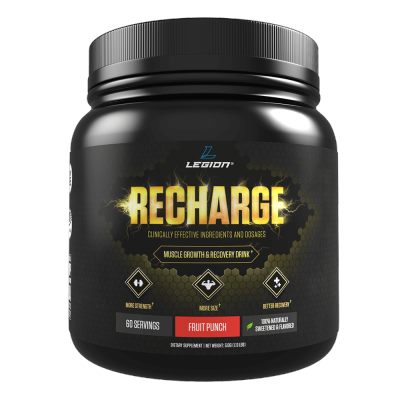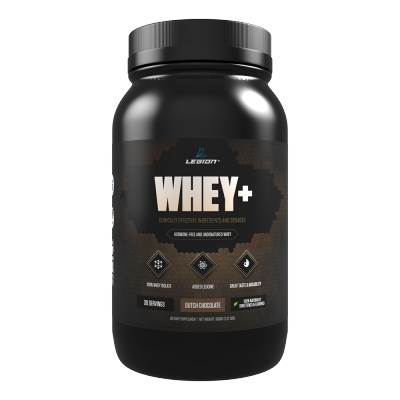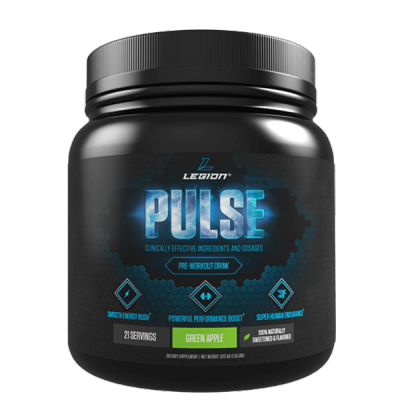I already like you.
You know why?
You’re not searching for a chest workout. You’re not wondering how to get bigger biceps, or better abs.
You want to do what most people don’t. You want to build a powerful, sexy lower body, and you probably know what that means.
Work. Hard work.
But you also probably know the payoff. Namely, not winding up like this dude:
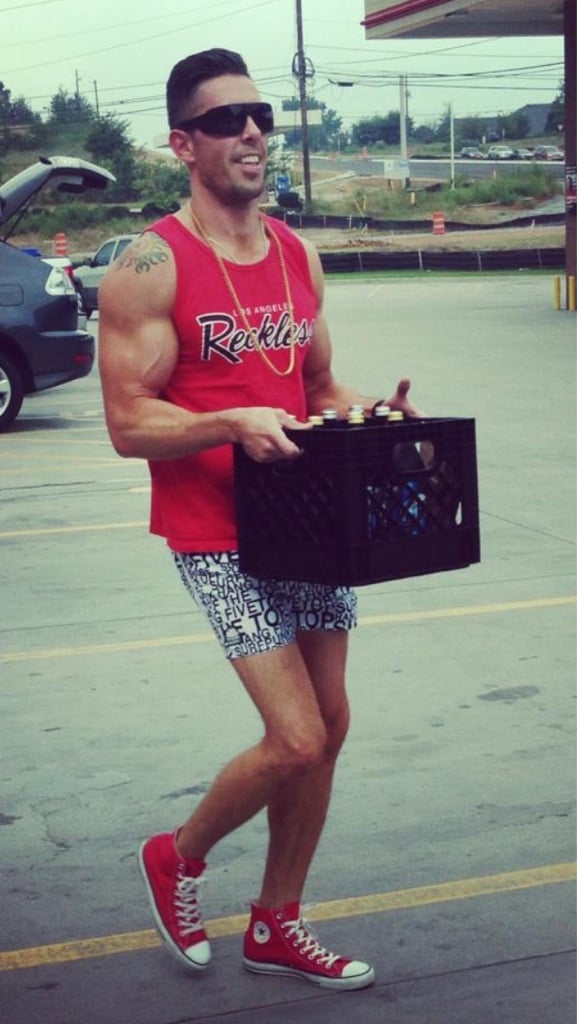
And if you’re a gal, getting yourself some gams and glutes like this:

Well, if I’m right in my assumptions, then you’ve come to the right place.
In this article, I’m going to teach you what it really takes to build a lower body that you can be proud of, and I’m going to give you an effective lower body workout that will get the needle moving right away.
As you’ll see, it’s not complicated, but it’s also not as simple as doing more squats or endless sets of leg extensions and curls.
Sure, squats are a fantastic lower body exercise (one of the best, in fact), but they shouldn’t be the only tool at your disposal. And while I like the hamstring curl, I don’t recommend the leg extension (more on why later).
I have some good news, too.
Contrary to popular belief, you don’t need to live in the gym and suffer through hours and hours of grueling workouts every week to get the body you really want.
You have to work hard, yes, but it doesn’t have to take forever, and you can actually enjoy the process along the way.
So, let’s get started, shall we?
The Primary Muscles Involved in Lower Body Workouts
A good lower body workout trains several major muscle groups:
- The quadriceps
- The hamstrings
- The calves
- The glutes
Each of these are best trained by different exercises, and each have “special needs” if you’re going to achieve maximal development and definition.
Let’s take a moment to discuss them separately.
The Best Way to Train Your Quadriceps
The quadriceps are a set of four large muscles on the front of your legs:
- The vastus lateralis.
- The vastus medialis.
- The vastus intermedius.
- The rectus femoris.
(Interestingly, new research indicates there’s a fifth muscle involved, so maybe we should be talking about the quintraceps instead?)
Here’s how they look:
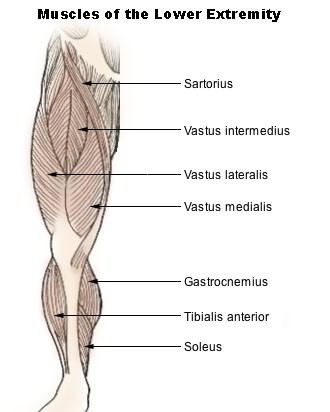
Together the quadriceps muscles work to extend the knees and flex the hips.
Thus, quadriceps exercises bring the hip from an extended to a flexed position (bending the joint) and bring the knee from a flexed to an extended position (straightening the joint).
When the quads are well developed, they form the centerpiece of the legs.
Case in point:
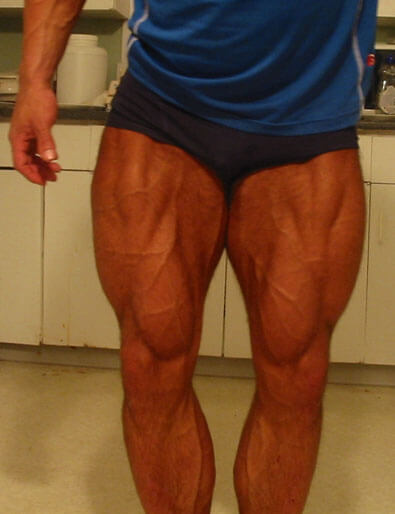
Quads aren’t just for guys, either.
If you’re a woman, whose legs would you prefer?
Hers?
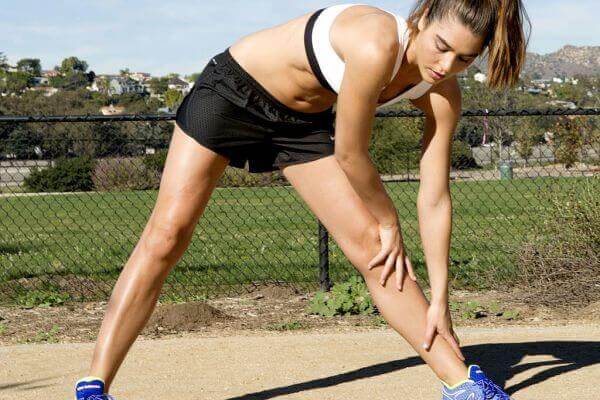
Or hers?
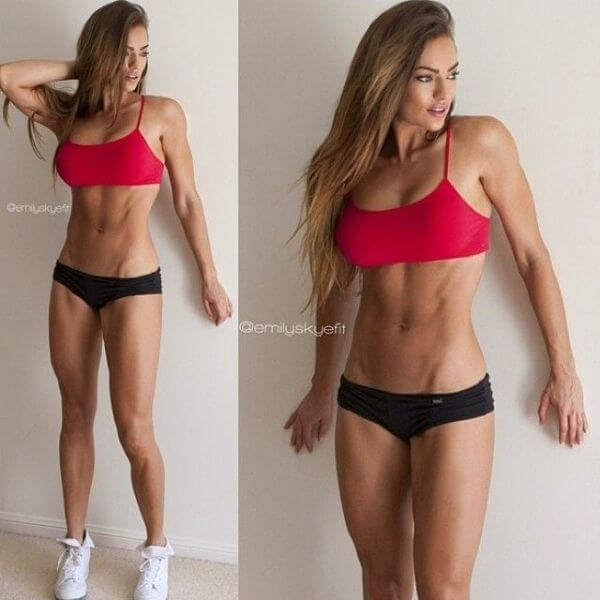
If you’re like most women I know, you’d choose door number two.
And getting there will require gaining quite a bit of muscle in your legs, including your quadriceps (no, this doesn’t have to make you “bulky,” either).
Now, many people believe that you can get all of the quad development you need from lots of heavy back squatting.
The back squat is a fantastic exercise for your quads (and entire lower body), but for optimal quad development, you should do others as well, including front squats and lunges.
As you’ll see, the best quads exercises that you can do are mostly compound exercises, and mostly involve using free weights.
You also may notice that one of the more popular quads exercises that isn’t on the list: the leg extension.
The reason I left it off is it’s not great for your knees, and especially when you use heavier weights.
The Best Way to Train Your Hamstrings
The hamstrings are a group of three muscles on the back of your legs:
- Semitendinosus
- Semimembranosus
- Biceps femoris
Here’s how they look:
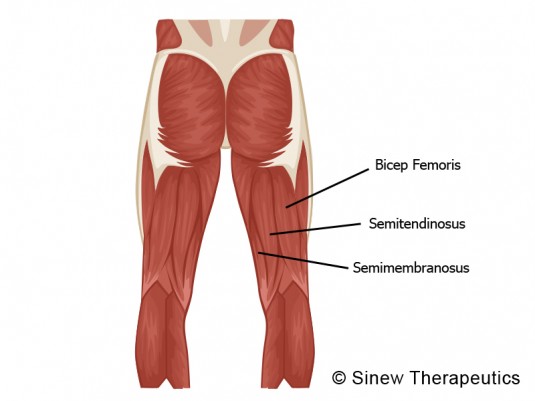
The biceps femoris is also split into two “heads” or sections, just like the biceps in your arm.
Unlike the biceps, however, the hamstrings tend to be one of the most neglected muscles of the lower body.
The quads get most of the attention because they’re larger and more visible, and this can create a muscular imbalance between the front and back of the thighs that looks strange and increases the risk of injury.
Many people also think that squatting is all you need for your hamstrings, and this is mistaken.
While the squat does involve the hamstrings, the quads do the lion’s share of the work. And this is especially true with the type of squatting that you often seen in the gym (quarter- and half-repping).
So, a good rule of thumb is to always include exercises that target your hamstrings in your lower body workouts, in addition to your quads-dominant exercises.
The Best Way to Train Your Glutes
The gluteus muscles, or “glutes,” are comprised of three muscles that form your butt:
- The gluteus maximus.
- The gluteus minimus.
- The gluteus medius.
Here’s how they look:
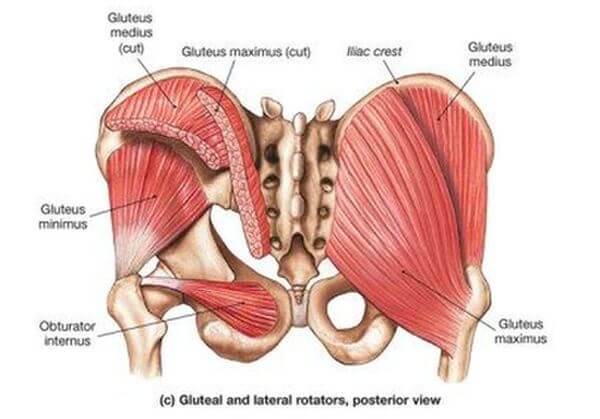
They’re for more than just show, too.
Together, they play a key role in stabilizing your body during all kinds of movement, and generating force in exercises like the deadlift and squat.
Now, if you’re doing a lot of your lower body training correctly, you don’t have to do additional training for your glutes.
That said, if you feel your glutes are a weak point in your physique, or if you just want maximum booty, then you’ll want to include exercises that specifically target them.
I’m going to assume the latter for the sake of this article, so as you’ll see, the lower body workout provided below contains a handful of sets just for the glutes.
The Best Way to Train Your Calves
The calves are comprised of two muscles:
- The soleus.
- The gastrocnemius.
Here’s what they look like:
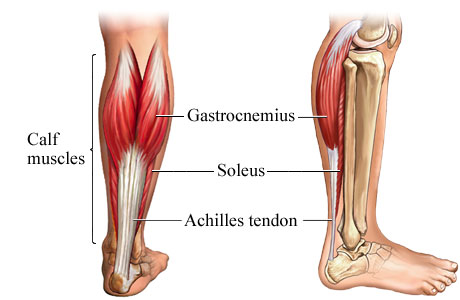
The calves are the forearms of the lower body.
They’re small, stubborn muscles that take their sweet time to grow, and some people just have them naturally, while others were destined for spindles (*raises hand*).
The reason for this is in the composition of the muscle fibers themselves.
- Some people’s calves have a high concentration of fast twitch muscle fibers, which have a large potential for strength and growth.
These types of calves respond remarkably to training, and can grow big and strong fairly quickly.
- On the other hand, some of us have calves with a high concentration of slow twitch fibers, which have a high capacity for endurance, but not for size and strength.
These types of calves take a tremendous amount of work to develop.
All this is why some people go so far as to say that you shouldn’t even bother training calves, because “it’s all genetics, anyway.”
They’re wrong.
Even the losers of the calf genetic lottery (like me) can escape the doldrums of dress legs. We just have to work harder and wait longer than the winners.
The Simple Science of Effective Lower Body Training
There are many ways to train the muscles in your lower body.
You can do bodyweight exercises, machines, or free weights. You can use lighter weights for more reps or heavier weights for fewer. You can train your lower body once, twice, or thrice per week, or even more frequently.
What’s best way?
Well, I’ve helped thousands of people of all ages and circumstances build muscle and lose fat faster than ever before, and here are the biggest lessons that I’ve learned:
1. You want to do a lot of heavy compound weightlifting.
The best types of workout programs for natural weightlifters are those that focus on heavy compound exercises like the squat, deadlift, bench press, and military press.
Sure, you can gain muscle and strength in many different ways, but decades of scientific and anecdotal evidence have conclusively proven that this is the most effective approach.
The reason heavy compound weightlifting is so powerful is simple: it’s the best way to progressively overload your muscles.
That is, it’s the best way to increase tension levels in your muscles over time, which is the primary driver of muscle growth.
This is why your number one goal in your resistance training should be to increase whole-body strength, and why the strongest people in the gym are also generally the biggest.
2. You want to make sure your weekly volume is right.
By “weekly volume,” I’m referring to the total number of reps that you perform for each major muscle group each week.
If you do too little work on any muscle group, it’ll progress slower than it could, and if you do too much, you’ll eventually run into problems related to overtraining.
Now, the first thing that you should know about training volume is this:
The heavier you train, the lower your weekly volume needs to be.
The reason for this is it takes your muscles and body longer to recover from heavy weightlifting than lighter training. This is why popular powerlifting programs look so austere compared to the nonsense you find in most bodybuilding magazines.
The subject of optimal training volume is rather complex, but here’s what you need to know for the purposes of this article:
Research shows that when you’re using weights in the range of 60 to 85% of one-rep max, optimal volume appears to be in the range of 60 to 180 reps per major muscle group per week.
As you can guess, the lower end of this range corresponds with the heaviest weightlifting, and the higher end with the lightest.
Now, if you’re worried that this means I’m going to ask you to do 3-hour lower body workouts a few days per week, you can breathe a sigh of relief.
Instead, I’m going to ask you to do a handful of compound exercises that train multiple major muscle groups at the same time, allowing you to rack up volume across your entire lower body much faster than you can with isolation exercises.
For example, while the squat primarily trains the quads, it also heavily involves the hamstrings and glutes, which means you don’t need to do as much direct hammy and glute training to give them the volume they need to grow bigger and stronger.
Alright, so now that we’ve covered our fundamental training philosophy for our lower body workouts, let’s talk exercises.
The Best Lower Body Exercises
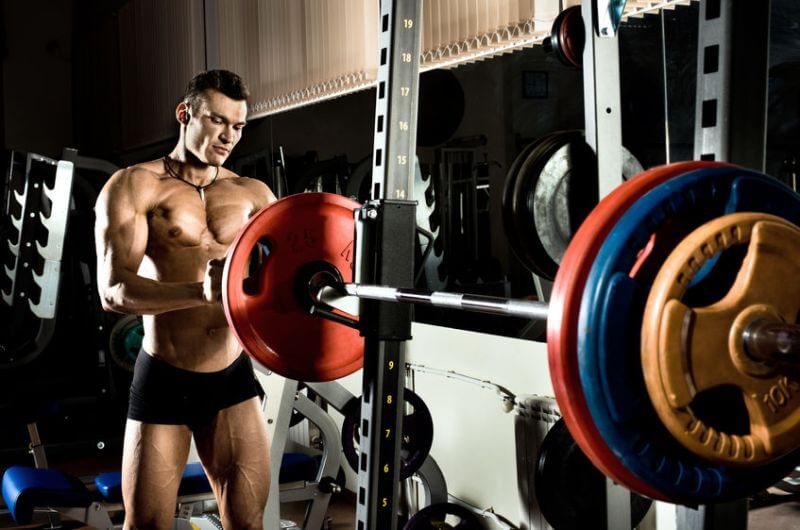
There are literally thousands of lower body exercises to choose from, and just as many opinions as to which are good and which aren’t.
Sorting and weighing the information can be damn near impossible without help, so that’s what I’m going to do here for you.
Below you’ll find a list of the most effective lower body exercises that you can do (with links to videos on how to do each).
You don’t have to do these exercises and only these for the rest of your life, but they’re all you really need to build the lower body of your dreams.
The Best Quad Exercises
Lunges
- Incline
- Seated
Step Ups
The Best Hamstring Exercises
- Seated
- Lying
The Best Glute Exercises
Deadlift
Hip Thrust
Lunge
The Best Exercises for Calves
Standing Calf Raise
Seated Calf Raise
That’s it.
If you make it your mission to master and progress on those movements, you’ll have no trouble developing your lower body.
Now, you’ve probably noticed that there isn’t much in the way of cable work, machines, or bodyweight exercises.
The reason for this is while those exercises do have a place in some people’s training (experienced bodybuilders, for example), free weight exercises are going to serve your needs better.
The Ultimate Lower Body Workout
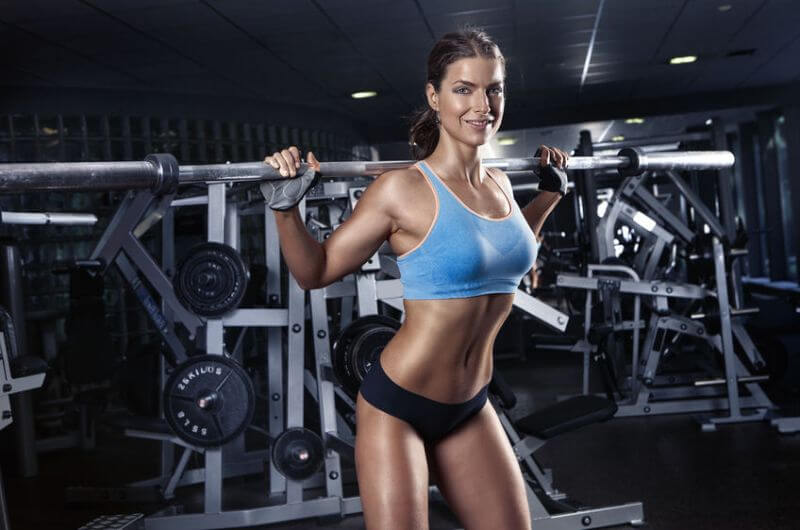
Alright, we’re finally ready to get into the gym, and put some plates on the bar.
So, here’s what I want you to do once every 4 days (day 1: train, 2, 3, 4: rest, 5: train, and so on).
Barbell Back Squat
Men & Experienced Female Weightlifters
Warm up and 2 sets of 4 to 6 reps (80 to 85% of 1RM)
Women New to Weightlifting
Warm up and 2 sets of 8 to 10 reps (70 to 75% of 1RM)
Front Squat
Men & Experienced Female Weightlifters
2 sets of 4 to 6 reps
Women New to Weightlifting
2 sets of 8 to 10 reps (70 to 75% of 1RM)
Bulgarian Split Squat
Men & Women
2 sets of 8 to 10 reps
Romanian Deadlift
Men & Women
2 sets of 8 to 10 reps
Optional
If you want to grow your butt even faster, include these sets in your workouts.
Hip Thrust
Men & Women
3 sets of 8 to 10 reps
Optional
If you want to grow your calves even faster, include these sets in your workouts.
Standing Calf Raise
Men & Women
3 sets of 8 to 10 reps
That’s a tough workout, but it shouldn’t take you more than 75 to 90 minutes, and it’ll hit every muscle in your lower body.
There are a few other things that you should know to get the most out of it:
1. Once you hit the top of your rep range for one set, you move up in weight.
For instance, if push out 6 (or 10) reps on your first set of squats, you add 5 pounds to each side of the bar for your next set and work with that weight until you can squat it for 6/10 reps, and so forth.
2. Rest 3 to 4 minutes in between each 4-to-6-rep set, and 2 minutes in between 8-to-10-rep sets.
Getting adequate rest in between sets is important because it allows your muscles to fully recoup their strength so you can give maximum effort each set.
3. Make sure you’re eating enough food.
Most people know that high protein intake is necessary to maximize muscle growth but don’t know that caloric intake also plays a major role.
You can learn more about this here.
Oh and FYI, this type of training is the core of my Bigger Leaner Stronger (for men) and Thinner Leaner Stronger (for women) programs, and I have hundreds of success stories that prove its effectiveness.
If you give this workout a go and like it, I highly recommend you check out BLS/TLS because you’re going to love it.
Happy training!
What About Supplements?
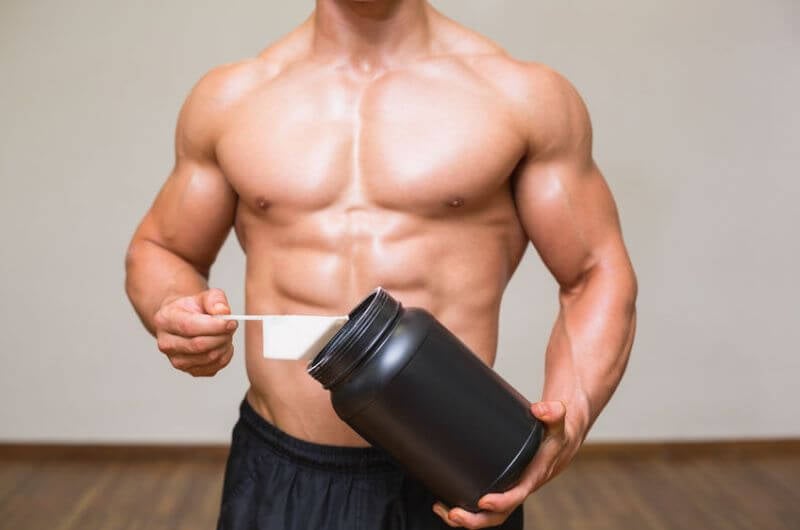
I saved this for last because, quite frankly, it’s far less important than proper diet and training.
You see, supplements don’t build great physiques–dedication to proper training and nutrition does.
Unfortunately, the workout supplement industry is plagued by pseudoscience, ridiculous hype, misleading advertising and endorsements, products full of junk ingredients, underdosing key ingredients, and many other shenanigans.
Most supplement companies produce cheap, junk products and try to dazzle you with ridiculous marketing claims, high-profile (and very expensive) endorsements, pseudo-scientific babble, fancy-sounding proprietary blends, and flashy packaging.
So, while workout supplements don’t play a vital role in building muscle and losing fat, and many are a complete waste of money…the right ones can help.
The truth of the matter is there are safe, natural substances that have been scientifically proven to deliver benefits such as increased strength, muscle endurance and growth, fat loss, and more.
As a part of my work, it’s been my job to know what these substances are, and find products with them that I can use myself and recommend to others.
Finding high-quality, effective, and fairly priced products has always been a struggle, though.
That’s why I took matters into my own hands and decided to create my own supplements. And not just another line of “me too” supplements–the exact formulations I myself have always wanted and wished others would create.
I won’t go into a whole spiel here, but if you want to learn more about my supplement line, check this out. (And if you’d like to know exactly what supplements to take to reach your fitness goals, take the Legion Supplement Finder Quiz.)
For the purpose of this article, let’s just quickly review the supplements that are going to help you get the most out of your lower body (and other) workouts.
Creatine
Creatine is a substance found naturally in the body and in foods like red meat. It’s perhaps the most researched molecule in the world of sport supplements–the subject of hundreds of studies–and the consensus is very clear:
Supplementation with creatine helps…
You may have heard that creatine is bad for your kidneys, but these claims have been categorically and repeatedly disproven. In healthy subjects, creatine has been shown to have no harmful side effects, in both short- or long-term usage. People with kidney disease are not advised to supplement with creatine, however.
If you have healthy kidneys, I highly recommend that you supplement with creatine. It’s safe, cheap, and effective.
In terms of specific products, I use my own, of course, which is called RECHARGE.
RECHARGE is 100% naturally sweetened and flavored and each serving contains:
- 5 grams of creatine monohydrate
- 2100 milligrams of L-carnitine L-tartrate
- 10.8 milligrams of corosolic acid
This gives you the proven strength, size, and recovery benefits of creatine monohydrate plus the muscle repair and insulin sensitivity benefits of L-carnitine L-tartrate and corosolic acid.
Protein Powder
You don’t need protein supplements to gain muscle, but, considering how much protein you need to eat every day to maximize muscle growth, getting all your protein from whole food can be impractical.
That’s the main reason I created (and use) a whey protein supplement. (There’s also evidence that whey protein is particularly good for your post-workout nutrition.)
WHEY+ is 100% naturally sweetened and flavored whey isolate that is made from milk sourced from small dairy farms in Ireland, which are known for their exceptionally high-quality dairy.
I can confidently say that this is the creamiest, tastiest, healthiest all-natural whey protein powder you can find.
Pre-Workout Drink
There’s no question that a pre-workout supplement can get you fired up to get to work in the gym. There are downsides and potential risks, however.
Many pre-workout drinks are stuffed full of ineffective ingredients and/or minuscule dosages of otherwise good ingredients, making them little more than a few cheap stimulants with some “pixie dust” sprinkled in to make for a pretty label and convincing ad copy.
Many others don’t even have stimulants going for them and are just complete duds.
Others still are downright dangerous, like USPLabs’ popular pre-workout “Jack3d,”which contained a powerful (and now banned) stimulant known as DMAA.
Even worse was the popular pre-workout supplement “Craze,” which contained a chemical similar to methamphetamine.
The reality is it’s very hard to find a pre-workout supplement that’s light on stimulants but heavy on natural, safe, performance-enhancing ingredients like beta-alanine, betaine, and citrulline.
And that’s why I made my own pre-workout supplement. It’s called PULSE and it contains 6 of the most effective performance-enhancing ingredients available:
- Caffeine. Caffeine is good for more than the energy boost. It also increases muscle endurance and strength.
- Beta-Alanine. Beta-alanine is a naturally occurring amino acid that reduces exercise-induced fatigue, improves anaerobic exercise capacity, and can accelerate muscle growth.
- Citrulline Malate. Citrulline is an amino acid that improves muscle endurance, relieves muscle soreness, and improves aerobic performance.
- Betaine. Betaine is a compound found in plants like beets that improves muscle endurance, increases strength, and increases human growth hormone and insulin-like growth factor 1 production in response to acute exercise.
- Ornithine. Ornithine is an amino acid found in high amounts in dairy and meat that reduces fatigue in prolonged exercise and promotes lipid oxidation (the burning of fat for energy as opposed to carbohydrate or glycogen).
- Theanine. Theanine is an amino acid found primarily in tea that reduces the effects of mental and physical stress, increases the production of nitric oxide, which improves blood flow, and improves alertness, focus, attention, memory, mental task performance, and mood.
And what you won’t find in PULSE is equally special:
- No artificial sweeteners or flavors..
- No artificial food dyes.
- No unnecessary fillers, carbohydrate powders, or junk ingredients.
The bottom line is if you want to know what a pre-workout is supposed to feel like…if you want to experience the type of energy rush and performance boost that only clinically effective dosages of scientifically validated ingredients can deliver…then you want to try PULSE.
Again, if you feel confused about what supplements you should take to reach your goals, take the Legion Supplement Finder Quiz to learn exactly what supplements are right for you. It’s the best way to ensure you get the most out of your supplement regimen.
The Bottom Line on Lower Body Workouts
Getting a great lower body isn’t nearly as difficult as you might think.
Yes, you have to keep showing up and putting in the work, but if you just follow the advice in this article, you’ll have no trouble building the legs and butt of your dreams.
And if you’re new to this style of training, then you’re in for a real treat, because your body is going to be hyper-responsive to it.
So, do these lower body workouts, push yourself to get stronger in each of the exercises, eat right, and take the right supplements, and your lower body will transform before your very eyes.
Happy training!
What’s your take on lower body workouts? Have anything else to share? Let me know in the comments below!
Scientific References +
- Peterson, M. D., Rhea, M. R., & Alvar, B. A. (2005). Applications of the dose-response for muscular strength development: A review of meta-analytic efficacy and reliability for designing training prescription. Journal of Strength and Conditioning Research, 19(4), 950–958. https://doi.org/10.1519/R-16874.1
- A L Goldberg, J D Etlinger, D F Goldspink, C. J. (n.d.). Mechanism of Work-Induced Hypertrophy of Skeletal Muscle - PubMed. Retrieved July 8, 2020, from https://pubmed.ncbi.nlm.nih.gov/128681/
- Gollnick, P. D., Sjödin, B., Karlsson, J., Jansson, E., & Saltin, B. (1974). Human soleus muscle: A comparison of fiber composition and enzyme activities with other leg muscles. Pflügers Archiv European Journal of Physiology, 348(3), 247–255. https://doi.org/10.1007/BF00587415
- Yavuz, H. U., Erdağ, D., Amca, A. M., & Aritan, S. (2015). Kinematic and EMG activities during front and back squat variations in maximum loads. Journal of Sports Sciences, 33(10), 1058–1066. https://doi.org/10.1080/02640414.2014.984240
- Arendt, E., & Dick, R. (1995). Knee injury patterns among men and women in collegiate basketball and soccer: NCAA data and review of literature... presented at the 19th annual meeting of the AOSSM, Sun Valley, Idaho, July 1993. American Journal of Sports Medicine, 23(6), 694–701. https://doi.org/10.1177/036354659502300611
- Holcomb, W. R., Rubley, M. D., Lee, H. J., & Guadagnoli, M. A. (2007). Effect of hamstring-emphasized resistance training on hamstring:quadriceps strength ratios. Journal of Strength and Conditioning Research, 21(1), 41–47. https://doi.org/10.1519/R-18795.1
- Powers, C. M., Ward, S. R., Fredericson, M., Guillet, M., & Shellock, F. G. (2003). Patellofemoral Kinematics during Weight-Bearing and Non-Weight-Bearing Knee Extension in Persons with Lateral Subluxation of the Patella: A Preliminary Study. Journal of Orthopaedic and Sports Physical Therapy, 33(11), 677–685. https://doi.org/10.2519/jospt.2003.33.11.677
- Grob, K., Ackland, T., Kuster, M. S., Manestar, M., & Filgueira, L. (2016). A newly discovered muscle: The tensor of the vastus intermedius. Clinical Anatomy, 29(2), 256–263. https://doi.org/10.1002/ca.22680
